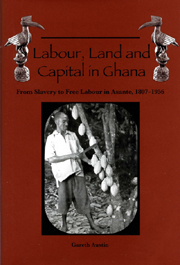Book contents
- Frontmatter
- Contents
- List of Illustrations
- List of Tables
- Preface
- Note on Names
- Maps
- Note on the Maps
- 1 Introduction
- Part I Context and Concepts
- Part II Social Relations of Production and Trade, 1807–1896: Absent and Imperfect Factor Markets
- 5 Land Tenure, 1807–1896
- 6 The Mobilization of Labour, 1807–1896
- 7 Capital and Credit, 1807–1896
- Part III Slavery as Hobson's Choice: An Analysis of the Interaction of Markets and Coercion in Asante's Era of ‘Legitimate Commerce’, 1807–1896
- Part IV The Decline of Coercion in the Factor Markets of Colonial Asante: Cocoa and the Ending of Slavery, Pawnship and Corvée, 1896–c.1950
- Part V Social Relations of Production and Trade, 1908–1956: Towards Integrated Factor Markets?
- Part VI Freedom and Forest Rent, 1908–1956
- Abbreviations Used in the Notes
- Notes
- List of References
- Index
6 - The Mobilization of Labour, 1807–1896
from Part II - Social Relations of Production and Trade, 1807–1896: Absent and Imperfect Factor Markets
Published online by Cambridge University Press: 12 September 2012
- Frontmatter
- Contents
- List of Illustrations
- List of Tables
- Preface
- Note on Names
- Maps
- Note on the Maps
- 1 Introduction
- Part I Context and Concepts
- Part II Social Relations of Production and Trade, 1807–1896: Absent and Imperfect Factor Markets
- 5 Land Tenure, 1807–1896
- 6 The Mobilization of Labour, 1807–1896
- 7 Capital and Credit, 1807–1896
- Part III Slavery as Hobson's Choice: An Analysis of the Interaction of Markets and Coercion in Asante's Era of ‘Legitimate Commerce’, 1807–1896
- Part IV The Decline of Coercion in the Factor Markets of Colonial Asante: Cocoa and the Ending of Slavery, Pawnship and Corvée, 1896–c.1950
- Part V Social Relations of Production and Trade, 1908–1956: Towards Integrated Factor Markets?
- Part VI Freedom and Forest Rent, 1908–1956
- Abbreviations Used in the Notes
- Notes
- List of References
- Index
Summary
Contrary to the conceited assumption that the social organization of our industrial societies is uniquely complex, it is arguable that the social organization of labour in—for example—nineteenth-century Asante was more complicated still. This is epitomized by the difficulty of separating familial from extra-familial sources of labour, or non-market from market ones. Slaves originated outside the family, indeed usually from outside the society, but over successive generations their descendants were treated increasingly as junior kin. Pawns were extra-familial workers to the master who received them; but in serving as pawns these individuals were usually fulfilling an obligation to their own matrikin, and the contract under which they laboured was fundamentally one between matrilineages (this will be detailed in Chapter 7). Again, the institutions of slavery and pawning had major non-market features; yet there was a market in slaves and even in pawns.
It seems clear that at any given moment throughout the period the majority of able-bodied people were working for themselves or in conjugal or kin-based units. To reflect this fundamental point the various forms of such labour will be discussed in the first section, which will also consider other forms of labour based on (at least proximately) non-market relationships: including subjects' work for chiefs. Yet it was the kinds of labour that could be recruited through a market that offered the main opportunities to principals (individuals, household heads, chiefs) to achieve economic and demographic expansion.
- Type
- Chapter
- Information
- Labour, Land and Capital in GhanaFrom Slavery to Free Labour in Asante, 1807–1956, pp. 106 - 134Publisher: Boydell & BrewerPrint publication year: 2005

